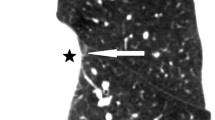Abstract
Objectives
To retrospectively evaluate short linear shadows connecting pulmonary segmental arteries to oblique fissures in thin-section CT images and determine their anatomical basis.
Methods
CT scanning was performed on 108 patients and 11 lung specimens with no lung diseases around the oblique fissures or hila. Two radiologists evaluated the imaging. The parameters included length, thickness of short linear shadows, pulmonary segmental artery variations, and traction interlobar fissures, etc.
Results
The short linear shadows were not related to sex, age, or smoking history. The lengths of the short linear shadows were generally within 10 mm. The thicknesses of the short linear shadows ranged from 1 to 2 mm. Of the patients, 26.9 % showed pulmonary segmental artery variations; 66.7 % of short linear shadows pulled oblique fissures. In three-dimensional images, the short linear shadows appeared as arc planes, with one side edge connected to the oblique fissure, one side edge connected to a pulmonary segmental artery. On the tissue slices, the short linear shadow exhibited a band structure composed of connective tissues, small blood vessels, and small lymphatic vessels.
Conclusions
Short linear shadows are a type of normal intrapulmonary membranes and can maintain the integrity of the oblique fissures and hilar structure.
Key Points
• Volumetric thin-section CT scanning is commonly used to study lung anatomy.
• Short linear shadows are a common intrapulmonary structure in thin-section CT.
• Short linear shadows correlate with band structures on the correlative tissue slices.





Similar content being viewed by others
Abbreviations
- CT:
-
Computed tomography
- HU:
-
Hounsfield unit
- MPR:
-
Multiplanar reformat
- 3D:
-
Three-dimensional
- MIP:
-
Maximum intensity projection
- VR:
-
Volume rendering
References
Cronin P, Gross BH, Kelly AM, Patel S, Kazerooni EA, Carlos RC (2010) Normal and accessory fissures of the lung: evaluation with contiguous volumetric thin-section multidetector CT. Eur J Radiol 75:e1–e8
Schieman C, MacGregor JH, Kelly E, Graham A et al (2011) Can preoperative computed tomography of the chest predict completeness of the major pulmonary fissure at surgery? Can J Surg 54:252–256
Koenigkam-Santos M, de Paula WD, Owsijewitsch M et al (2013) Incomplete pulmonary fissures evaluated by volumetric thin-section CT: semi-quantitative evaluation for small fissure gaps identification, description of prevalence and severity of fissural defects. Eur J Radiol 82:2365–2370
Berkmen YM, Drossman SR, Marboe CC et al (1992) Intersegmental (intersublobar) septum of the lower lobe in relation to the pulmonary ligament: anatomic, histologic, and CT correlations. Radiology 185:389–393
Zuo YZ, Liu C, Liu SW (2013) Pulmonary intersegmental planes: imaging appearance and possible reasons leading to their visualisation. Radiology 267:267–275
Rost RC Jr, Proto AV (1983) Inferior pulmonary ligament: computed tomographic appearance. Radiology 148:479–483
Cooper C, Moss AA, Buy JN, Stark DD (1983) CT appearance of the normal inferior pulmonary ligament. AJR Am J Roentgenol 141:237–240
Webb WR (2006) Thin-section CT of the secondary pulmonary lobule: anatomy and the image—the 2004 Fleischner lecture. Radiology 239:322–338
Rabinowitz JG, Wolf BS (1966) Roentgen significance of the pulmonary ligament. Radiology 87:1013–1020
Heitzman ER (1984) The lung: radiologic-pathologic correlations, 2nd edn. Mosby London Kimpton, St Louis
Janssens JP, Pache JC, Nicod LP (1999) Physiological changes in respiratory function associated with ageing. Eur Respir J 13:197–205
Ensor RE, Fleg JL, Kim YC, de Leon EF, Goldman SM (1983) Longitudinal chest x ray changes in normal men. J Gerontol 38:307–314
Copley SJ, Wells AU, Hawtin KE et al (2009) Lung morphology in the elderly: comparative CT study of subjects over 75 years old versus those under 55 years old. Radiology 251:566–573
Glazer HS, Anderson DJ, DiCroce JJ, Solomon SL et al (1991) Anatomy of the major fissure: evaluation with standard and thin-section CT. Radiology 180:839–844
Berkmen YM, Auh YH, Davis SD, Kazam E (1989) Anatomy of the minor fissure: evaluation with thin-section CT. Radiology 170:647–651
George BM, Nayak SB, Marpalli S (2014) Morphological variations of the lungs: a study conducted on Indian cadavers. Anat Cell Biol 47:253–258
Sealy WC, Connally SR, Dalton ML (1993) Naming the bronchopulmonary segments and the development of pulmonary surgery. Ann Thorac Surg 55:184–188
Hogg JC, McDonough JE, Sanchez PG et al (2009) Micro–computed tomography measurements of peripheral lung pathology in chronic obstructive pulmonary disease. Proc Am Thorac Soc 15:546–549
Scott AE, Vasilescu DM, Seal KA et al (2015) Three dimensional imaging of paraffin embedded human lung tissue samples by micro-computed tomography. PLoS One 10:e0126230
Acknowledgments
We are grateful to Hui Chen and Jian-feng Lei from the Capital Medical University for statistical analyse and micro-CT imaging, respectively. We thank American Journal Experts for providing language editing services. The scientific guarantor of this publication is Da-Qing Ma. The authors of this manuscript declare no relationships with any companies, whose products or services may be related to the subject matter of the article. The authors state that this work has not received any funding. Hui Chen kindly provided statistical advice for this manuscript. Institutional Review Board approval was obtained. Written informed consent of patients was waived by the Institutional Review Board. Written informed consent of autopsies was obtained from all family members of patients in this study. Methodology: retrospective, case-control study / cross sectional study, performed at one institution.
Author information
Authors and Affiliations
Corresponding author
Rights and permissions
About this article
Cite this article
Guan, CS., Ma, DQ., Cui, D. et al. Short linear shadows connecting pulmonary segmental arteries to oblique fissures in volumetric thin-section CT images: comparing CT, micro-CT and histopathology. Eur Radiol 26, 2740–2748 (2016). https://doi.org/10.1007/s00330-015-4107-3
Received:
Revised:
Accepted:
Published:
Issue Date:
DOI: https://doi.org/10.1007/s00330-015-4107-3




